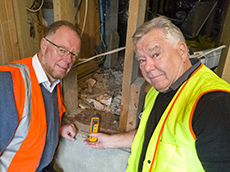Too many Wellington houses in need of repair
One in eight Wellington houses on the market is considered to have major maintenance problems and over half are dangerously damp, according to analysis by Victoria University of Wellington.

One in eight Wellington houses on the market is considered to have major maintenance problems and over half are dangerously damp, according to analysis by Victoria University of Wellington.
The research analysed a sample from twelve years of data from building inspections carried out on stand-alone houses in Wellington by Buildsure Associates Ltd.
“What is worrying is that houses are in general a person’s most expensive asset, yet at best only one in five houses for sale is showing up in good repair,” says Dr Nigel Isaacs, co-author and senior lecturer in Victoria’s School of Architecture.
“One in eight of the houses was considered to have major maintenance problems that exceed general wear and tear.”
Dr Isaacs says the project, carried out collaboratively by Victoria University and Buildsure Associates, complements the work of the house condition survey by building research agency BRANZ. “It has boosted our knowledge in this area and will help to inform homeowners and the industry of the main issues facing our houses.”
Data for the study was taken from a random sample of seventy inspection reports, and collated for analysis by Victoria Summer Scholarship student Beth Noble and Master of Building Science student Ethan Duff.
Ten common problems were identified—asbestos, concrete spalling, corrosion, decay of timber, electrics, external water management, movement, subfloor moisture, subfloor structure and wall moisture.
Thirty-six percent of houses in the sample were likely to have asbestos present in either the roof or wall cladding, thirty-five percent had high moisture levels, and fifty-three percent had insufficient subfloor ventilation with the potential to lead to decay and corrosion.
“Many of these may have potential health and safety implications for the house owners or occupiers,” says Dr Isaacs.
The problems found are not unique to Wellington or New Zealand but are issues that can be commonly seen in stand-alone timber housing, says Dr Isaacs.
“Half the houses analysed had dangerously high moisture loads in a number of places. A lot of the issues relate to water being in the wrong place or the houses being poorly designed or constructed.”
The research, co-authored by Dr Isaacs, Buildsure Associates director Jim Bowler and student Ethan Duff, has recently been published by Springer as a chapter in the book Case Studies of Building Pathology in Cultural Heritage.
